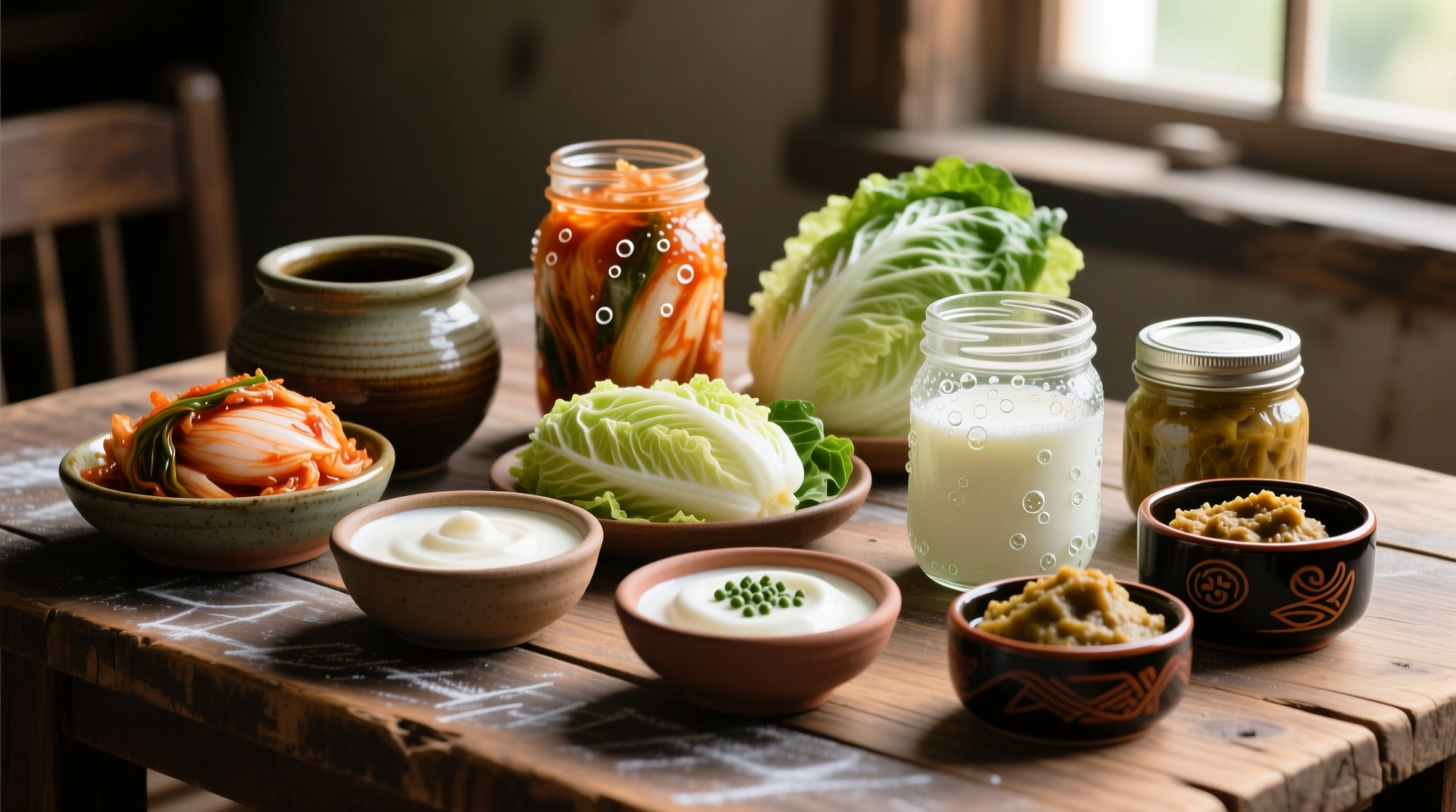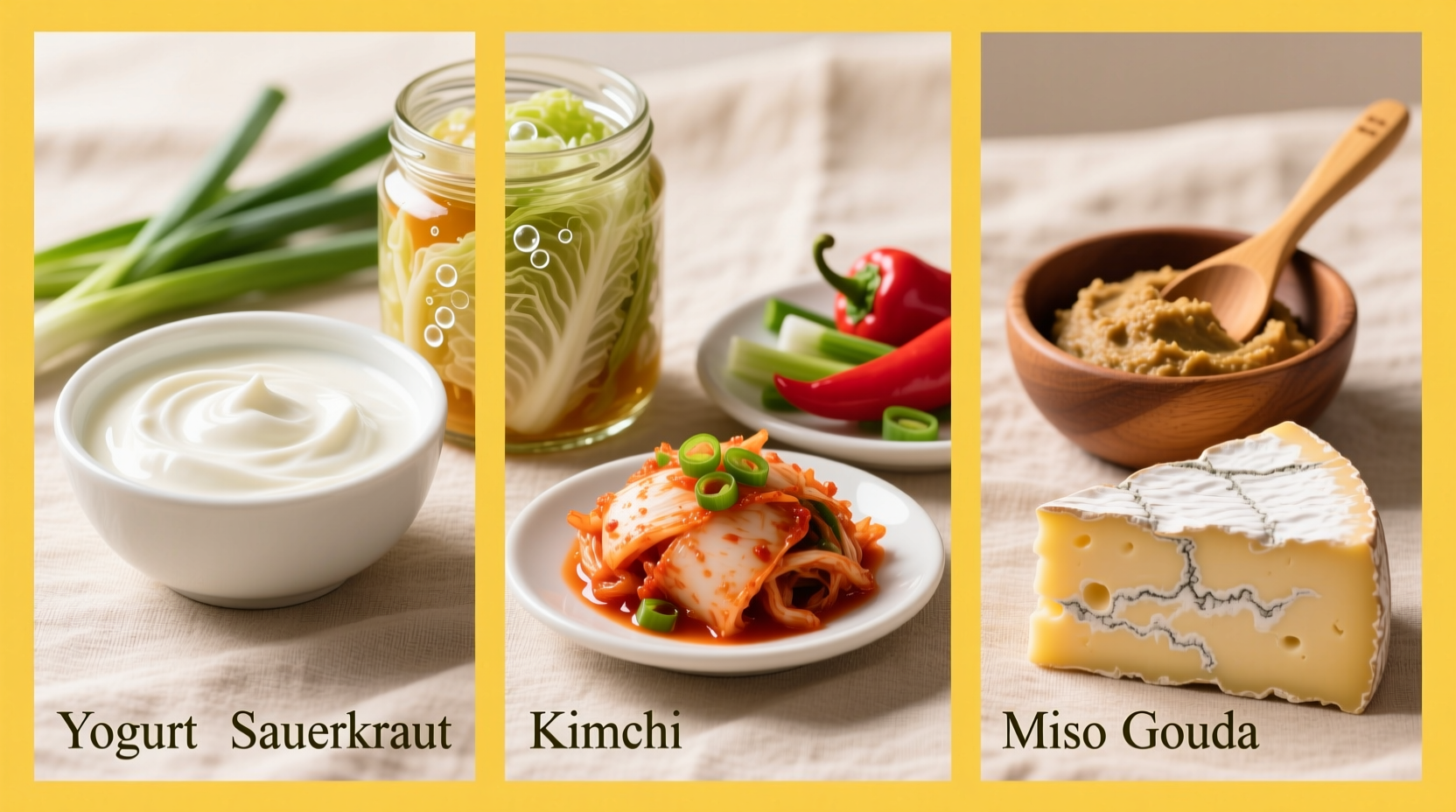Yogurt, kefir, sauerkraut, kimchi, miso, tempeh, kombucha, and certain cheeses like Gouda are among the top natural food sources of probiotics. These fermented foods contain live beneficial bacteria that support gut health when consumed regularly as part of a balanced diet.
Discover exactly which foods deliver the most effective probiotic strains for digestive wellness, how much you need to eat for benefits, and practical ways to incorporate them into your daily meals—without expensive supplements or complicated routines.
Your Complete Guide to Probiotic-Rich Foods
When searching for what foods have probiotics in them, you're likely looking for natural, accessible ways to boost your gut health. Probiotics—live microorganisms that provide health benefits when consumed—play a crucial role in digestion, immune function, and even mental wellbeing. But not all fermented foods qualify as probiotic sources, and understanding the difference can make or break your gut health strategy.
Why Probiotic Foods Matter More Than You Think
According to research from the National Institutes of Health, the human gut contains trillions of microorganisms forming a complex ecosystem essential for overall health. Consuming probiotic-rich foods helps maintain this delicate balance, particularly after antibiotic use or during digestive distress. Unlike supplements, food-based probiotics come packaged with additional nutrients that enhance their effectiveness.
| Probiotic Food | Key Strains | Minimum Live Cultures per Serving | Best Time to Consume |
|---|---|---|---|
| Yogurt (with live cultures) | L. bulgaricus, S. thermophilus | 1 billion CFU | Morning with breakfast |
| Kefir | L. kefiri, L. acidophilus | 5-10 billion CFU | Between meals |
| Unpasteurized Sauerkraut | L. plantarum, P. pentosaceus | 10 million CFU | With lunch |
| Kimchi | L. sakei, L. plantarum | 100 million CFU | With dinner |
This comparison of natural sources of probiotics in food reveals why not all fermented options deliver equal benefits. Pasteurization kills live cultures, which is why store-bought sauerkraut often lacks probiotic value unless specifically labeled "raw" or "unpasteurized." The International Scientific Association for Probiotics and Prebiotics (ISAPP) emphasizes that for a food to qualify as probiotic, it must contain documented strains at sufficient levels to confer health benefits.
Dairy-Based Probiotic Powerhouses
Yogurt remains the most accessible probiotic food for many consumers. Look for products labeled "contains live and active cultures" with at least 1 billion colony-forming units (CFU) per serving. Greek yogurt often undergoes straining that removes some beneficial bacteria, making traditional yogurt a better probiotic choice.
Kefir outperforms yogurt with its wider variety of strains and higher concentration of live cultures. This fermented milk beverage contains up to 61 different strains of beneficial bacteria and yeast, according to research published in the Journal of Dairy Science. Its liquid consistency allows for faster delivery of probiotics through the digestive tract.

Plant-Based Probiotic Options
For those avoiding dairy, several excellent plant-based options exist. Fermented vegetables like kimchi and sauerkraut contain lactic acid bacteria that survive stomach acid to reach the intestines. Authentic kimchi (not the vinegar-based versions common in some restaurants) provides Lactobacillus sakei, which research from Children's Hospital of Philadelphia shows may help combat sinus infections.
Miso and tempeh offer probiotic benefits while delivering complete plant protein. Tempeh's fermentation process breaks down soybeans' natural phytic acid, making nutrients more bioavailable. Natto, a traditional Japanese fermented soybean product, contains Bacillus subtilis which produces vitamin K2—essential for bone and cardiovascular health.
Smart Consumption Strategies
Maximizing the benefits of probiotic-rich foods for gut health requires strategic consumption. Probiotics work best when paired with prebiotics—fibers that feed beneficial bacteria. Combine your probiotic foods with prebiotic-rich options like bananas, onions, garlic, and oats.
Temperature matters: heating probiotic foods above 115°F (46°C) kills live cultures. Add miso to soups after removing from heat, and use sauerkraut as a cold topping rather than cooking it. Storage conditions also affect viability—keep fermented vegetables submerged in their brine and refrigerated to maintain live cultures.
When Food Sources Fall Short
While probiotic foods for digestive health offer numerous benefits, certain situations may require supplementation. After antibiotic treatment, higher-dose probiotic supplements might be necessary to restore gut balance quickly. Individuals with severe digestive disorders like Crohn's disease or ulcerative colitis should consult healthcare providers about appropriate probiotic strains.
The Harvard T.H. Chan School of Public Health notes that food-based probiotics generally provide more diverse microbial communities than supplements, which typically contain 1-10 strains versus the dozens found in fermented foods. However, supplements offer standardized dosing that food sources can't match consistently.
Avoiding Common Probiotic Food Mistakes
Many consumers unknowingly purchase products that don't deliver probiotic benefits. Commercial pickles made with vinegar rather than saltwater fermentation lack live cultures. Most store-bought kombucha undergoes pasteurization that kills beneficial bacteria unless specifically labeled "raw" or "unpasteurized."
Some cheeses contain probiotics, but only those aged without heat treatment. Gouda, mozzarella, cheddar, and cottage cheese made from raw milk offer the most benefits. The Academy of Nutrition and Dietetics recommends checking cheese labels for "contains live cultures" to ensure probiotic content.
Building Your Daily Probiotic Routine
Start your day with 6-8 ounces of kefir or yogurt. Include 2-4 ounces of fermented vegetables with lunch, and add miso to dinner recipes. This approach delivers multiple probiotic strains throughout the day, creating a more resilient gut microbiome than single-strain supplements.
Track your digestive response for 2-4 weeks. Many people notice reduced bloating, more regular bowel movements, and improved energy levels. Remember that probiotic effects are strain-specific—what works for one person might not work for another, so be patient while finding your optimal combination of dairy and non-dairy probiotic foods.











 浙公网安备
33010002000092号
浙公网安备
33010002000092号 浙B2-20120091-4
浙B2-20120091-4